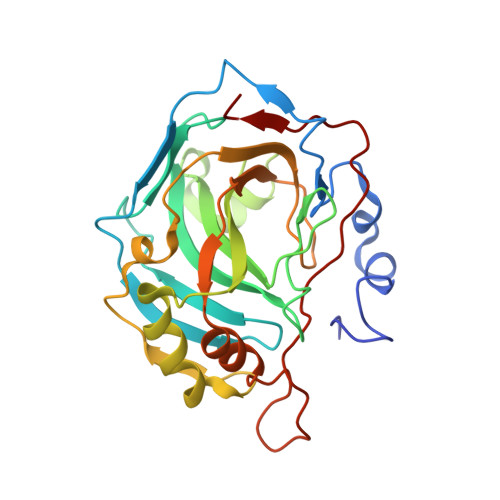Carbonic Anhydrase Activators. Activation of Isoforms I, II, IV, VA, VII, and XIV with l- and d-Phenylalanine and Crystallographic Analysis of Their Adducts with Isozyme II: Stereospecific Recognition within the Active Site of an Enzyme and Its Consequences for the Drug Design.
Temperini, C., Scozzafava, A., Vullo, D., Supuran, C.T.(2006) J Med Chem 49: 3019-3027
- PubMed: 16686544
- DOI: https://doi.org/10.1021/jm0603320
- Primary Citation of Related Structures:
2FMG, 2FMZ - PubMed Abstract:
Activation of six human brain carbonic anhydrases (hCAs, EC 4.2.1.1), hCA I, II, IV, VA, VII, and XIV, with l-/d-phenylalanine was investigated kinetically and by X-ray crystallography. l-Phe was a potent activator of isozymes I, II, and XIV (K(A)s of 13-240 nM), a weaker activator of hCA VA and VII (K(A)s of 9.8-10.9 microM), and a quite inefficient hCA IV activator (K(A) of 52 microM). d-Phe showed good hCA II activatory properties (K(A) of 35 nM), being a moderate hCA VA, VII, and XIV (K(A)s of 4.6-9.7 microM) and a weak hCA I and IV activator (K(A)s of 63-86 microM). X-ray crystallography of the hCA II-l-Phe/d-Phe adducts showed the activators to be anchored at the entrance of the active site, participating in numerous bonds and hydrophobic interactions with amino acid residues His64, Thr200, Trp5, and Pro201. This is the first study showing different binding modes of stereoisomeric activators within the hCA II active site, with consequences for overall proton transfer processes (rate-determining for the catalytic cycle). It also points out differences of activation efficiency between various isozymes with structurally related activators, exploitable for designing alternative proton transfer pathways. CA activators may lead to the design of pharmacologically useful derivatives for the enhancement of synaptic efficacy, which may represent a conceptually new approach for the treatment of Alzheimer's disease, aging, and other conditions in which spatial learning and memory therapy must be enhanced. As the blood and brain concentrations of l-Phe are quite variable (30-73 microM), activity of some brain CAs may strongly be influenced by the level of activator(s) present in such tissues.
Organizational Affiliation:
Universit¨¤ degli Studi di Firenze, Laboratorio di Chimica Bioinorganica, Rm. 188, Via della Lastruccia 3, I-50019 Sesto Fiorentino (Firenze), Italy.

















